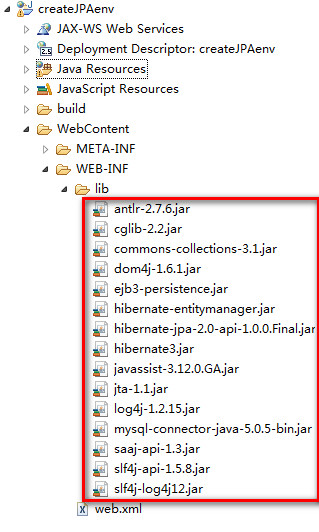hibernate虽然好用但编写映射文件还是比较麻烦,虽然可以借助插件但是后期的维护还是比较麻烦,jpa的全称是Java Persistence API,实现该规范的产品很多像hibernate就是其中比较出名的一个,原则上应该尽量不要使用hibernate,可惜jpa只是一个接口规范,自 己按照规范写一套也不现实,只能通过hibernate间接的使用jpa.
1 使用hibernate的jpa实现需要的jar包如下

我用的是hibernate3.6的版本,如果是低版本的hibernate则还需要hibernate-commons-annotations.jar、hibernate-annotations.jar
2 persistence.xml的相关配置
jpa和hibernate类似需要一个类似hibernate.cfg.xml的配置文件,该文件指定要操作的相关数据库,内容如下
|
1
2
3
4
5
6
7
8
9
10
11
12
13
14
15
16
17
18
19
20
21
22
|
<?
xml
version
=
"1.0"
encoding
=
"UTF-8"
?>
<
persistence
xmlns
=
"http://java.sun.com/xml/ns/persistence"
xmlns:xsi
=
"http://www.w3.org/2001/XMLSchema-instance"
xsi:schemaLocation="http://java.sun.com/xml/ns/persistence
http://java.sun.com/xml/ns/persistence/persistence_1_0.xsd"
version
=
"1.0"
>
<
persistence-unit
name
=
"myPersistUnit"
transaction-type
=
"RESOURCE_LOCAL"
>
<
provider
>org.hibernate.ejb.HibernatePersistence</
provider
>
<
properties
>
<
property
name
=
"hibernate.hbm2ddl.auto"
value
=
"update"
/>
<!-- 数据库的相关配置 -->
<
property
name
=
"hibernate.connection.driver_class"
value
=
"com.mysql.jdbc.Driver"
/>
<
property
name
=
"hibernate.connection.url"
value
=
"jdbc:mysql://127.0.0.1:3306/exercise?useUnicode=true&characterEncoding=UTF-8"
/>
<
property
name
=
"hibernate.connection.username"
value
=
"root"
/>
<
property
name
=
"hibernate.connection.password"
value
=
"123456"
/>
<!-- 指定方言 -->
<
property
name
=
"hibernate.dialect"
value
=
"org.hibernate.dialect.MySQL5Dialect"
/>
<
property
name
=
"hibernate.show_sql"
value
=
"false"
/>
<
property
name
=
"hibernate.format_sql"
value
=
"true"
/>
</
properties
>
</
persistence-unit
>
</
persistence
>
|
相信学过hibernate应该能看懂这个配置文件,需要注意的是persistence-unit节点的name属性,这个名称后面将会用到,另外这个 文件的名称只能是persistence.xml不能是别的名称且必须放在src下面的META-INF文件夹下面,如果不存在可以手动创建。
3 编写实体类
实体是jpa中比较重要的一部分,它承担着POJO和类似hibernate映射文件的功能,算得上是jpa的核心文件,下面这个是其中一个例子
|
1
2
3
4
5
6
7
8
9
10
11
12
13
14
15
16
17
18
19
20
21
22
23
24
25
26
27
28
29
30
31
32
33
34
35
36
37
38
39
40
41
42
43
44
45
46
47
48
49
50
51
52
53
54
55
56
57
58
|
package
org.lxh.info;
import
java.util.Date;
import
javax.persistence.Column;
import
javax.persistence.Embedded;
import
javax.persistence.Entity;
import
javax.persistence.EnumType;
import
javax.persistence.Enumerated;
import
javax.persistence.GeneratedValue;
import
javax.persistence.GenerationType;
import
javax.persistence.Id;
import
javax.persistence.Table;
import
javax.persistence.Temporal;
import
javax.persistence.TemporalType;
@Entity
@Table
(name =
"m_users"
)
public
class
User {
private
int
id;
private
String name;
private
Date birthday;
private
Sex sex;
@Id
@GeneratedValue
public
int
getId() {
return
id;
}
public
void
setId(
int
id) {
this
.id = id;
}
@Column
(length=
20
,nullable=
false
)
public
String getName() {
return
name;
}
public
void
setName(String name) {
this
.name = name;
}
@Temporal
(TemporalType.DATE)
public
Date getBirthday() {
return
birthday;
}
public
void
setBirthday(Date birthday) {
this
.birthday = birthday;
}
@Enumerated
(EnumType.STRING)
@Column
(length=
5
,nullable=
false
)
public
Sex getSex() {
return
sex;
}
public
void
setSex(Sex sex) {
this
.sex = sex;
}
}
|
@Entity 这个注解表明这个java类是一个实体对象
@Table 该注解用来指定实体对应的表,默认情况下表名和实体类的名称相同
@Id 该注解用来指定主键
@GeneratedValue 该注解配置的是主键的生成策略
@Column 该注解用于指定数据库表对于的列名、唯一约束、非空约束等
@Temporal 主要用于日期属性上面,可以指定日期的类型
@Lob 指定映射到数据库的字段为大文本数据或者字节数组
@Enumerated 指定对于的属性为枚举
4 编写简单的JPA工具类
|
1
2
3
4
5
6
7
8
9
10
11
12
13
14
15
|
package
org.lxh.util;
import
javax.persistence.EntityManager;
import
javax.persistence.EntityManagerFactory;
import
javax.persistence.Persistence;
public
final
class
JpaUtil {
private
static
EntityManagerFactory em;
static
{
em=Persistence.createEntityManagerFactory(
"myPersistUnit"
);
}
public
static
EntityManager getEntityManager(){
return
em.createEntityManager();
}
}
|
5 JPA的crud基本操作
|
1
2
3
4
5
6
7
8
9
10
11
12
13
14
15
16
17
18
19
20
21
22
23
24
25
26
27
28
29
30
31
32
33
34
35
36
37
38
39
40
41
42
43
44
45
46
47
48
49
50
51
52
53
54
55
56
57
58
59
60
61
62
63
64
65
66
67
68
69
70
71
72
73
74
75
76
77
78
79
80
81
82
83
84
85
86
87
88
89
90
91
92
93
94
95
96
97
98
99
100
101
102
103
104
105
106
107
108
109
110
111
112
113
114
115
116
117
118
119
120
121
122
123
124
125
126
127
128
129
130
131
132
133
|
package
org.lxh.test;
import
static
org.junit.Assert.*;
import
java.util.*;
import
javax.persistence.EntityManager;
import
javax.persistence.EntityTransaction;
import
javax.persistence.Query;
import
org.lxh.info.Sex;
import
org.lxh.info.User;
import
org.lxh.util.JpaUtil;
public
class
Test {
@org
.junit.Test
public
void
testInsert() {
EntityManager em=
null
;
EntityTransaction tx=
null
;
try
{
em=JpaUtil.getEntityManager();
tx=em.getTransaction();
tx.begin();
User u=
new
User();
u.setBirthday(
new
Date());
u.setName(
"潘玮柏"
);
u.setSex(Sex.MAN);
em.persist(u);
tx.commit();
}
catch
(Exception e){
e.printStackTrace();
}
finally
{
if
(em!=
null
){
em.close();
}
}
}
@org
.junit.Test
public
void
testUpdate() {
EntityManager em=
null
;
EntityTransaction tx=
null
;
try
{
em=JpaUtil.getEntityManager();
tx=em.getTransaction();
tx.begin();
User u=
new
User();
u.setId(
2
);
u.setName(
"周杰伦"
);
u.setSex(Sex.MAN);
u.setBirthday(
new
Date());
em.merge(u);
tx.commit();
}
catch
(Exception e){
e.printStackTrace();
}
finally
{
if
(em!=
null
){
em.close();
}
}
}
@org
.junit.Test
public
void
testDelete() {
EntityManager em=
null
;
EntityTransaction tx=
null
;
try
{
em=JpaUtil.getEntityManager();
tx=em.getTransaction();
tx.begin();
User u=em.find(User.
class
,
2
);
em.remove(u);
tx.commit();
}
catch
(Exception e){
e.printStackTrace();
}
finally
{
if
(em!=
null
){
em.close();
}
}
}
/**
* 最简单的查询
*/
@org
.junit.Test
public
void
testJPLQuery() {
EntityManager em=
null
;
EntityTransaction tx=
null
;
try
{
em=JpaUtil.getEntityManager();
String jpl=
"select u from User u"
;
Query q=em.createQuery(jpl);
List<User> all=q.getResultList();
Iterator<User> it=all.iterator();
while
(it.hasNext()){
User user=it.next();
System.out.println(user.getName()+
","
+user.getBirthday());
}
}
catch
(Exception e){
e.printStackTrace();
}
finally
{
if
(em!=
null
){
em.close();
}
}
}
/**
* 使用命名参数的方式更新数据
*/
@org
.junit.Test
public
void
testJPLUpdate() {
EntityManager em=
null
;
EntityTransaction tx=
null
;
try
{
em=JpaUtil.getEntityManager();
String jpl=
"update User u set u.name=:name where u.id=:id"
;
Query q=em.createQuery(jpl);
q.setParameter(
"name"
,
"加菲猫"
);
q.setParameter(
"id"
,
3
);
q.executeUpdate();
}
catch
(Exception e){
e.printStackTrace();
}
finally
{
if
(em!=
null
){
em.close();
}
}
}
}
|
最后来分析一下jpa的缺点:
1> 提供的主键生成策略较少
2>没有缓存机制
3> 实体类中注解和java代码混合在一起,可读性降低了
来自:http://blog.youkuaiyun.com/walkcode/article/details/39103277








 本文详细介绍如何使用Java Persistence API (JPA) 进行数据库操作,包括配置文件、实体类定义、工具类编写及CRUD基本操作,并分析了JPA的一些不足之处。
本文详细介绍如何使用Java Persistence API (JPA) 进行数据库操作,包括配置文件、实体类定义、工具类编写及CRUD基本操作,并分析了JPA的一些不足之处。
















 548
548

 被折叠的 条评论
为什么被折叠?
被折叠的 条评论
为什么被折叠?








